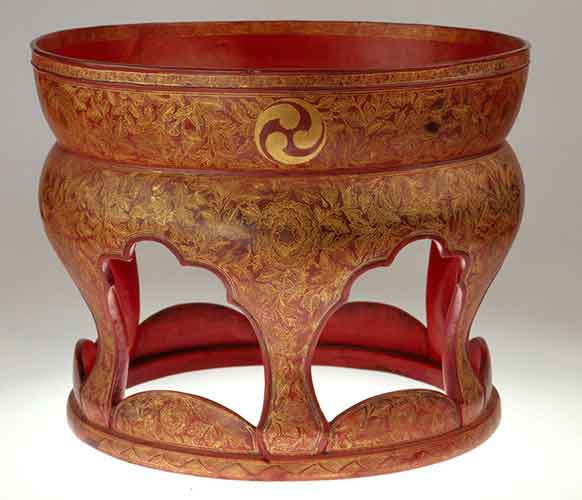Lacquer Offering Stand from Okinawa
This lacquer offering stand from Okinawa comes from the Ruyuku Kingdom (1429–1879), which controlled an extensive maritime trade network and played a key role in the cultural and economic exchange between China and Japan at a critical point in the histories of all three civilizations. Among the greatest treasures of the museum’s collection is a gold and red lacquer offering stand, made in the 17th to 18th century for the Ryukyu court and decorated with the crest of the royal family – it is one of only three to survive and is now held in the collection of the Honolulu Museum of Art in Hawaii.
Lacquerware is one of the chief artistic products of the Ryukyu Islands, which is today the Okinawa Prefecture of Japan, and represents a form and style of lacquerware which is distinct from that of the surrounding cultures. Though distinct in its own ways, it is strongly influenced by Chinese, Japanese, and Southeast Asian styles.
Ryukyuan lacquerware is distinguished by the use of inlaid seashells and various native Ryukyuan artistic motifs, and a strong tendency towards red lacquer, which is rather less common in the rest of Japan. Though the styles and techniques of producing lacquerware were originally introduced to Ryukyu by China, native motifs gradually came to be incorporated into the islands’ lacquerwares. Mother-of-pearl inlay is similarly not originally a Ryukyuan element, but it came to be used to depict papaya, plantain, palm trees, tomoe, and other motifs of the sub-tropical islands. Other designs, such as images of hibiscus and coral, were introduced in the latter half of the 20th century as part of the artificial cultural production of tourism goods. Traditionally, the use of yellow, green, and other colored lacquers to create designs against the red background is another distinctive Ryukyuan method.
See more objects from the Honolulu Museum of Art


